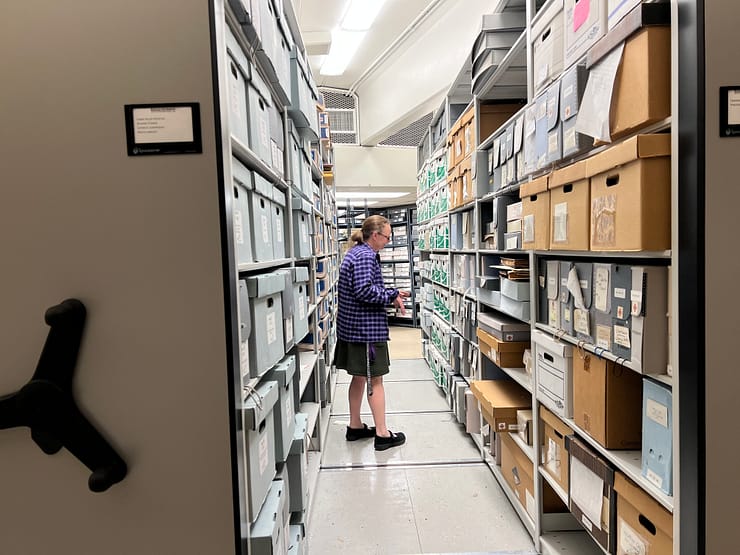St. Mike’s class on Edmundites in the Civil Rights Movement opens eyes, preserves legacy
Picture this: A white Catholic priest hand-in-hand with Civil Rights activist John Lewis when he awoke in the hospital following the events of Bloody Sunday in Selma, Alabama in March 1965.
That priest – Father Maurice Ouellet – a St. Mike’s alumnus, staff member, and member of the order that founded the College, touched history. His fingerprints are found in the way he cared for and marched with the African American community during the Civil Rights Movement and in the way he taught St. Mike’s students the value of service, standing up for justice, and valuing human life.
We don’t have an actual picture of that moment, but in the Saint Michael’s College archive are many other pictures, letters, official correspondence – a photo in the post office even depicts Dr. Martin Luther King, Jr. with another Edmundite priest – which tie this College to that important moment in history. It’s a legacy many St. Mike’s students are unaware of.
This spring semester, a class titled “Edmundites in the Civil Rights Movement” is changing that. And, as the Society of Saint Edmund stops accepting new members and draws to a close, preserving their stories becomes more important than ever.

Lily Maxted ’25 presents to her class – Edmundites in the Civil Rights Movement – what she learned from the College archives and through research concerning direct connections between the College and the Civil Rights Movement in the 1960s.
Understanding the Civil Rights Movement through the eyes of individuals
During a March evening class just days removed from the 60th anniversary of “Bloody Sunday” – the name given to the 1965 march from Selma to Montgomery, Alabama that turned violent – St. Mike’s students presented highlights from their mid-term research paper. Notably, they showed off a picture of the primary source document – which came from the College’s archive – that their paper was based upon. Letters hand-written in slanting script, photos with fading edges, and typed correspondence between the Bishop and the Society of Saint Edmund comprised the sources.
Jolivette Anderson-Douoning, the history professor teaching the class who is also the College’s inaugural Edmundite African American Fellow, said it was important to study individual experiences as a way to contextualize what was happening at the time, giving color and nuance often not found in a history book.

Jolivette Anderson-Douoning, history professor and Saint Michael’s College Edmundite African American Fellow, leads a discussion in March 2025 during the class entitled Edmundites in the Civil Rights Movement.
“My pedagogical style is to build a knowledge base so they can understand the lived experiences of the people in the South,” Anderson-Douoning said. She said currently, her class was focused on the experience of the Edmundites, the order of priests that founded Saint Michael’s College.
“What were the tensions that existed between white people – Catholics in the South – who were for segregation or against segregation or somewhere in the middle just trying to follow the laws of the state and society,” Anderson-Douoning cited as an example.
Liz Scott, the school’s archivist, pulled several decades’ worth of relevant materials from the Society of Saint Edmunds’s Southern Mission records. Most students’ projects concentrated on the time period of 1962 to 1965.
“These were priests going about their work, with parishes, with offices, with schools, and within communities who may have been involved with but at the very least were witness to some significant things,” Scott said. She added that there is great value in what these sources offer that are contained within seemingly ordinary, everyday files.
“Students were not told what was important—they had to read and discover on their own,” she said. “This tests their understanding of the time period, their understanding of the relationships uncovered and lets them draw their own conclusions.”
Edmundites fed, healed, registered, marched, and it fueled a movement
In 1937, the first group of Edmundites went to Selma, Alabama, to assist African American communities struggling under the weight of segregation because Pope Pius XI condemned fascism and Naziism across the globe. This was while tensions were mounting before World War II broke out.
“In light of that, the Edmundites went to Selma to answer the call because segregation is a form of fascism,” Anderson-Douoning explained. “The segregation that was against Black folks in the United States has this contradiction of ‘we’re about freedom and liberty but we enslave this group of people with south racial slavery.’”
At the Good Samaritan Clinic – later Hospital – the Edmundites fed the hungry and tended to the sick and injured. In the 1960s, as the Civil Rights Movement was gaining steam, the Edmundites were at the forefront of the movement, according to Fr. David Cray ’68, current Superior General of the Society of Saint Edmund.
“When it was too dangerous for any of the local Black pastors to do so, Maurice Ouellet, as pastor of Saint Elizabeth’s Mission (the Black Catholic parish of the time), welcomed the Student Non-Violent Coordinating Committee to establish their voter registration drive in our mission facilities,” Cray wrote of their involvement. “When the marchers were beaten on the Edmund Pettus Bridge on Bloody Sunday, none of the segregated white hospitals would accept the casualties. They were welcomed at our Good Samaritan (Black) Hospital.”
The Edmundites registered Black voters, and some even marched with protesters.

Photos and correspondence from the Society of Saint Edmunds’s Southern Mission archives in Selma, Alabama from the 1960s. Photos depict Fr. Maurice Ouellet ’48.
Fr. Ouellet was eventually expelled from that diocese and appointed Master of Novices for the Society of Saint Edmund – essentially training up new initiates to the Order in Connecticut. Fr. Cray was in Fr. Ouellet’s first class of novices.
“Maurice was ‘hot’ from his Selma experiences, and all of us who were his students in that and in subsequent years were ‘infected’ for the rest of our lives—each in his own way—with his passion for social justice and Civil Rights,” wrote Cray.
Fr. Cray himself would go to Selma in 1989; there he worked to help elect the first Black mayor in Selma, James Perkins, in 2000.
Students proud of the legacy left, but wish more knew about it
For students in Anderson-Douoning’s class, learning about the College’s connection to such a consequential historical moment was transformative.
“For many, these are the first historical documents they have ever held in their hands, and it is the greatest thing to see them react to them and connect them to something they have learned about in a book or lecture,” said College Archivist Scott.

Saint Michael’s College Archivist, Liz Scott, looks for files among the myriad of records stored in the College’s archive.
“I didn’t realize the tie between Edmundites and Civil Rights,” was a common refrain from students taking the class. This came from Preston Lilly ’26 who said he didn’t expect to learn priests who have worked at Saint Michael’s College went South to actively make a difference. He is an education major and hopes to impart the connection to future students.
“It’s somebody’s story that’s not really getting told,” he said.
Similarly, senior Lily Maxted ’25, a Sociology and Equity Studies major who loves history, said she was surprised she didn’t know more about the College’s ties to the movement before taking the class, and she is proud of the role Edmundites have played.
“The fact that we have such a personal connection with the College, it’s been really exciting and it just makes me feel very happy to go here,” Maxted said. “It’s just something special to learn about.”

Saint Michael’s College students presented how Edmundite priests contributed to the Civil Rights Movement while serving in Selma, Alabama during the 1960s.
The Edmundites’ actions of service also provided students an example worthy of following.
“It had me just reflect on my life, too,” said D’Niaya Settles ’28. “The Catholic identity, and we talked a little about what religion means to you and how that affects how you act and treat people.”
Added Courtney Williams ’28, “The legacy would be us being able to see what’s happening if there are injustices and then figuring out how we can also provide help.”And, Lydia Altman ’27 said the class drove home many of the Catholic connection to the signature programs found on campus.
“A lot of things we do – our service programs – a lot of them are connected to the Catholic teachings and you don’t realize that unless you are specifically told that,” Altman said. “I feel like the Edmundites are leading that, making sure it’s happening. I’m kind of nervous for when they complete the Order.”
As the Society prepares to sunset, a new light shines on their story
The Edmundite legacy is closely woven with Saint Michael’s College as many of the remaining members of the Catholic order reside and work at the College or have come through St. Mike’s during their tenure. The Society of Saint Edmund’s archives – from their founding in France in 1843 until now – reside in the basement of Durick Library on campus.

Fr. Maurice Ouellet ’48 in the midst of a bevy of school children in Selma, Alabama during the 1960s. Ouellet – along with other Edmundites – cared for and advocated on behalf of African American communities during the Civil Rights Movement.
As of 2022, the Society of Saint Edmund has halted accepting new members and prepares for “completion” of their charge.
Fr. Cray described the original mission, “to undertake whatever ministries—wherever that others were unable or perhaps unwilling to undertake.” At one point there were ministries in five countries on three continents usually in response to requests from local churches or the Vatican.
The society will continue as long as the last Edmundite lives. But, that means more responsibility rests on the College’s shoulders to make sure the Edmundite stories don’t pass into obscurity, particularly ones as important as their role in history during the Civil Rights Movement. To help accomplish this goal, the College founded a Division of Edmundite Mission in 2024, with an inaugural Vice President, Fr. David Theroux, SSE ’70, who sits on the College President’s cabinet.
Fr. Cray is proud of the work of the Edmundites in their Southern Missions and for still being identified with the African American community. He hopes other qualities of the Order are also preserved.
“I would like our spirit of adaptability and our willingness to try new things to continue as a hallmark of our successors in carrying on our legacy,” he said. “Also, I would point to our spirit and ease of cooperation with others—religious and lay — our egalitarianism, and our shunning of ‘pomp-and-circumstance.’”
He said classes like Anderson-Douoning’s and careful preservation of the archives will help.
This legacy extends to past, current and future students.

Fr. David Cray, S.S.E. ’68, Superior General of the Society of Saint Edmund.
Using history to inform the present, Anderson-Douoning hopes students take away how movements are made up of individuals who have organized in different ways and different places with a common goal. Those individuals didn’t always see that goal to completion but had a role to play.
“Like, the people that started this College – when they died, the College didn’t die,” Anderson-Douoning said during a recent class. “So, how do you create something that’s going to last way beyond you that’s for the public common good?” Anderson-Douoning is also imparting to her students her perspective, knowledge and unique connections. Classroom discussions are augmented by her lived experience as a Black woman from the South who has fought for equality and justice causes and who has studied extensively about the African American experience. Her ties and those of the Edmundites bind current and future students to that collective heritage. She expressed this during class, name-dropping some of those connections.
“Y’all getting a little Bob Moses, y’all getting a little Bernard Lafayette, y’all getting a little Ouellet all from this class experience” she said. “Because that’s the narrative — that’s how energy flows across generations. It’s maybe just a class, but it’s also a connection to the past.”
The spirit of the Society of Saint Edmund lives on, according to Fr. Cray, in a slogan from Father Francis Casey, who with Father John Paro founded the Edmundite Southern Missions in 1937: “To do the best we can, with what little we have, to help those most in need.”
More information on the Edmundites and the Division of Edmundite Mission can be found here.>>


